#amjad khan
Text
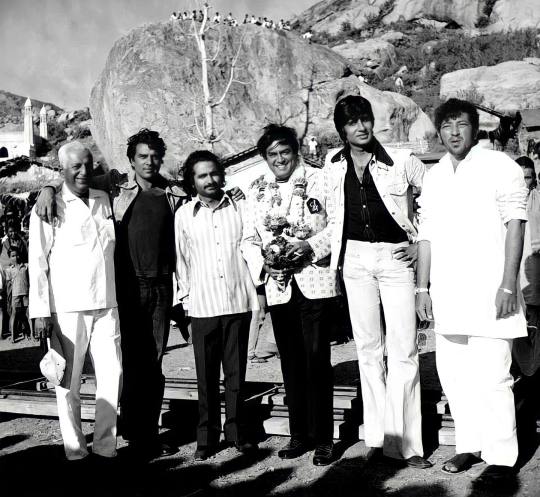
On the set of the 1975 movie 'Sholay', from left to right: Kewal Kishan Singh Deol (Dharmendra's father), Dharmendra, director Ramesh Sippy, Sanjeev Kumar, Amitabh Bachchan, and Amjad Khan.
#bollywoodirect#bollywood#sholay#amitabh bachchan#dharmendra#ramesh sippy#amjad khan#Kewal Kishan Singh Deol#sanjeev kumar
19 notes
·
View notes
Text
जालना में मुस्लिम समुदाय के होनहार छात्रों का सम्मान, शिक्षा के प्रति बढ़ता उत्साह
Promising students of Muslim community honored in Jalna, enthusiasm for education increasing
जालना: मुस्लिम परिवार अब अपने बच्चों की उच्च शिक्षा को लेकर बेहद जागरूक हो रहे हैं. समाज के छात्रों को भी अब अवसर मिलने पर अपनी प्रतिभा से समाज के विकास में योगदान देने का मौका मिल रहा है. यह विद्यार्थी अपने खानदान का नाम रोशन कर रहे है. ऐसे ही होनहार बच्चों का हौसला बढ़ाने के लिए पूर्व सभापति अकबर खान…
0 notes
Text
Vamba Sherif: films naspelen en leren dromen
De Liberiaans-Nederlandse schrijver Vamba Sherif (1973) werd in het Afrikaanse Liberia geboren en kwam als twintigjarige in ons land terecht. In het verhaal Flamboyante bomen verhaalt hij over een terugkeer naar zijn geboorteland.
Twintig jaar was ik weg geweest. Een periode waarin ik volwassen werd en waarin het land waar ik mij ooit in vele opzichten vreemd voelde, thuis bleek te zijn. Dat land…

View On WordPress
#21-ste eeuws#Amerikaans#Amitabh Bachchan#Amjad Khan#avocado#Bengali#berichten#bioscoop#bioscoopeigenaar#boom#Chinees#compound#de film#dood#dromen#echte wereld#filmavontuur#filmrollen#geboortedorp#geboorteland#grootste familie#herinneringen#Hindi#huizen#imitatie#Indiaas#Indiase films#kamer#Liberia#liedjes
0 notes
Text
चमेली की शादी Chameli Ki Shaadi Title Song Lyrics- Chameli Ki Shaadi
Hello friends if you are Looking Chameli Ki Shaadi Title song lyrics then you landed right place so don’t worry relaxed and enjoyed the Chameli Ki Shaadi movie all songs lyrics peacefully at one place. You can find and read this lyrics easily in any smartphone and Tablet such as Samsung, Motorola, Sony, Xiaomi, Vivo, Oppo, LG, Huawei, Asus, Lava, Micromax, iTel, Nokia, Oneplus, iphone, HTC and…

View On WordPress
0 notes
Text

Where our paths were supposed to end, where the turning point lay, forget it,
He who is with you now, behold him, he who is lost to you, forget him.

The rain that was meant for you, has poured itself on another roof
My naive heart listen to me, forget him, forget him.

I was lost in my thoughts of you, in my hopes of you, in my fancy for you,
The gentle breeze whispered in my ear, come near me, forget him.

In anyone's eyes, there are no tears of sorrow, even after you left, nothing is amiss,
Life has forgotten about you, you also smile, forget him,

The one you took as your moon, the one who had bloomed at your sea-shores
He was a sea of union for you which has receded now, forget him.
Amjad Islam Amjad
#amjad islam amjad#urdu#urdu poetry#desiblr#desi#pakistan#poetry#pakistani#desi academia#desi aesthetic#desi things#desi tag#desi tumblr#urduadab#urdu stuff#urdu lines#urdu ghazal#urdu shayari#khawabegul#mehreen khan#shayari#urdu literature#urduposts#poetry in translation#poetry blog#urdu poets#poets on tumblr
144 notes
·
View notes
Text
André 3000 Digs Jazz
André 3000 shares his favorite jazz songs
#André 3000#New Blue Sun#Jazz#i love that there's so much Steve Reich on here#Hiroshi Yoshimura#Laraaji#John Coltrane#Thelonious Monk#Amjad Ali Khan#Lakshmi Shankar#Igor Stravinsky#Steve Reich
19 notes
·
View notes
Video
youtube
(via Ustad Amjad Ali Khan | Rain Ragas | Megh & Miyan ki Malhar | Sarod & Double Tabla | Music of India)
13 notes
·
View notes
Text
Ye hai Zila Ghaziabad Lyrics
Singer:Nadeem Khan, Amjad BagadbaAlbum:Zila Ghaziabad
Tod ke gilli haayeArey chhod ke kanchaTod ke gilli, chhod ke kanchaThaam liya ji tamancha
Ghurraoon rijhaoonKabze me kisi ke na aaunAaun bajaaunMain be-baat danda uthaoonArey sabse pehle hum hainAur sab hain humre baadYeh hai Zila GhaziabadYeh hai Zila Ghaziabad
Dauda ke maree…Dauda ke mare shikari jaiseBhaag bhaag tu jaan bachakeBhaag naa…
0 notes
Text
A Raga Renaissance Flowers in Brooklyn

From left, Shiva Ghoshal, Arun Ramamurthy, Jay Gandhi and David Ellenbogen of Brooklyn Raga Massive jamming at Pioneer Works in Brooklyn.Credit...Loren Wohl for The New York Times
By Vivien Schweitzer
March 24, 2016
The jeweled raiment and serene kohl-rimmed eyes of Saraswati, the Hindu goddess of knowledge, music and the arts, were projected on a screen behind the stage one recent evening at Pioneer Works, the exhibition and performance space in Red Hook, Brooklyn.
With an ensemble that blended Western instruments and traditional Indian ones, the tabla and sarod, two vocalists — Roopa Mahadevan, wearing a glittery silver sari, and Haleh Kilmer, in dark jeans and boots — sang selections including a tribute to the goddess rendered by Ms. Mahadevan in the haunting melismatic style of southern India. The evening celebrated Indian female cultural figures as well as the female members of the Brooklyn Raga Massive, a dynamic nonprofit collaborative formed in 2012 with a mission to expose new audiences to Indian classical music.
Such weekly events, held in spaces around the city, highlight different elements of the raga, the backbone of Indian music, and conclude with lively late-night jam sessions in which any musician who observes the house rules is welcome to participate. The Massive’s free-floating operations are a vital part of a flowering of Indian music in New York.
On April 6, the collective will offer a birthday tribute to Ravi Shankar, the influential sitar player who collaborated with Western musicians including the violinist Yehudi Menuhin and the flutist Jean-Pierre Rampal. Mr. Shankar’s impact led The New York Times in 1966 to declare that the raga was “becoming a rage in America,” although it deemed it a “curious fad.” The Massive refers to its current contemporary movement as a raga renaissance.
Yet according to Par Neiburger, the artistic director of the World Music Institute, the Massive is unusual in that, in contrast to the top-down traditionalist approach of most Indian musical organizations, with fierce loyalty to individual teachers and a strict guru-disciple hierarchy, its structure is free-form and democratic.
“There is a lot of improvisation in Indian classical music,” Mr. Neiburger said. “But the basic forms lend themselves to a tradition that is kept intact and hasn’t really been modernized in any extreme way.”

Anoushka Shankar, the sitar-playing daughter of the renowned sitarist Ravi Shankar, who plans an American tour in April to promote her new album.Credit...Simon Scheuller
Recent events presented by the Massive at Pioneer Works, where the collaborative is in residence until April 27, have included explorations of the Hindustani music of northern India; Indian film and dance; a collaboration with African musicians like the Malian singer Awa Sangho; and a tribute to George Harrison and the Beatles. Coming events include an exploration of Carnatic music, the idiom of southern India, on Tuesday, March 29, and, on April 13, a lineup mixing Cuban rhythms with raga melodies.
The Massive has also explored the influence of Indian music on prominent Western classical composers like Terry Riley, performing his “In C,” a Minimalist work from 1964, last year at the Rubin Museum; a recording on the Northern Spy Records label is due out later this year. In a concert in September at Le Poisson Rouge in Greenwich Village, it will celebrate the birthday of John Coltrane, who was fascinated by Indian music.
As the central element of Indian music, the raga originated with the ancient Vedic hymns sung in Hindu temples and is intended to create a trancelike spiritual mood. (The word, derived from Sanskrit, translates as “passion” or “color.”) It is composed from scales with ascending and descending patterns that form a melodic framework for improvisation and is associated with seasons, moods and events. Ragas open with an introspective prelude called the alap (performed without percussion) that evolves into a rhythmically invigorating section with percussion that often features virtuoso solo segments.
Ragas are largely monophonic, incorporating drones created by instruments like the tanpura, a long-necked plucked string instrument.
A spellbinding concert presented in February at the 92nd Street Y by the World Music Institute illuminated the Carnatic genre at its most sublime. The violinist L. Subramaniam (whose father, V. Lakshminarayana, expanded the role of the violin in the Carnatic tradition from background to solo instrument) joined his son, Ambi Subramaniam, also a violinist, for a mesmerizing performance.
Gentle wisps of melody shared by the two men slowly unfolded over a drone before morphing into a flurry of imaginatively ornamented, virtuosic riffs. When they were joined by two percussionists (Mahesh Krishnamurthy on the mridangam and Ravi Balasubramanian on the ghatam), the music reached ecstatic heights.
Anoushka Shankar, the daughter of Mr. Shankar and a sitar player who both performs classical Indian music and a fusion incorporating other influences, said in an interview that the traditional music in its pure form is struggling in India, where Bollywood and fusion music promoted by the Indian television series “Coke Studio @ MTV,” are popular. “It’s hard to compete in a short-sound-bite-driven market when a form of music is by nature about a slowly unfolding genre,” said Ms. Shankar, who plans an American tour in April timed to the release of her new album, “Land of Gold.”
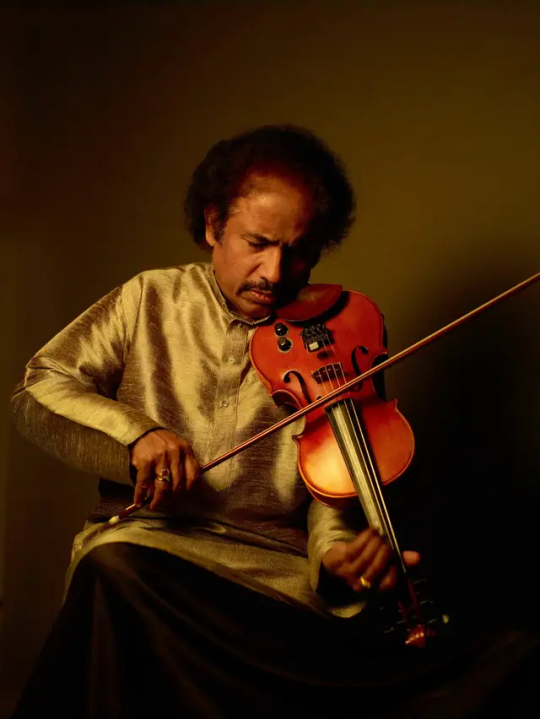
The violinist L. Subramaniam, who performed recently at the 92nd Street Y.
In the United States, Mr. Neiburger of the World Music Institute said, Indian classical music tends not to have “the broad appeal that some other world music genres might have, such as Brazilian music, fado and flamenco.” So the Massive teams up with others eager to attract new American listeners, like the Biryani Boys, a duo consisting of the tabla player David Freeman and the sitar player Mustafa Bhagat who also produce YouTube videos infused with hipster humor and featuring prominent Indian musicians.
On Saturday, April 2, at the Metropolitan Museum of Art, New Yorkers will have the chance to hear some of India’s most prominent musicians. Amjad Ali Khan will perform with his sons, Amaan and Ayaan Ali Khan, the seventh generation of a family of musicians who play the sarod, a long-necked lute prominent in classical northern Indian music.
Many of the Massive members perform Indian classical music in its pure form as well as experimenting with various fusions. An afternoon performance at the Met this month by the sitar player Neel Murgai and the tabla musician Sameer Gupta proved riveting, the soulful alap building in intensity to the colorful fast section called the jhalla.
In a contemporary music scene characterized above all by crossing and blurring genres, it’s possible to find all kinds of collaborations. Mr. Gupta and Mr. Murgai also perform with the violinists Arun Ramamurthy and Trina Basu, both trained in the Carnatic tradition, and the Western-trained cellist Marika Hughes as the Neel Murgai Ensemble. It performs what it describes as “raga chamber jazz,” a blend of Indian forms with everything from Tuvan throat singing to Roma tunes.
Ms. Basu also plays with the cellist Amali Premawardhana, the bassist Perry Wortman and the tabla player Roshni Samlal in the ensemble Karavika, which specializes in a soulful blend of classical and folk traditions from the United States and India.
The Massive members are proud of their open-minded outlook. “New forms are being created that are indigenous to Brooklyn,” Mr. Murgai said. As for the collective’s future goals, Mr. Gupta points out in a lighthearted Massive video that Pioneer Works is not far from the Statue of Liberty in New York Harbor.
“I have a dream,” he said, “that one day the statue won’t have a book and a torch but will have a sitar and a tabla.”
A version of this article appears in print on March 27, 2016, Section AR, Page 12 of the New York edition with the headline: A Raga Renaissance Flowers in Brooklyn.
#Amaan Ali Khan#Amali Premawardhana#Ambi Subramaniam#Amjad Ali Khan#Anoushka Shankar#Arun Ramamurth#Arun Ramamurthy#Awa Sangho#Ayaan Ali Khan#Biryani Boys#David Ellenbogen#David Freeman#George Harrison#Haleh Kilmer#Indian music#Jay Gandhi#Jean-Pierre Rampal#John Coltrane#Karavika#L. Subramaniam#Mahesh Krishnamurthy#Marika Hughes#Mustafa Bhagat#Neel Murgai#Par Neiburger#Perry Wortman#Ravi Balasubramanian#Ravi Shankar#Roopa Mahadevan#Roshni Samlal
0 notes
Audio
Listen/purchase: Sandhya by Amjad Ali Khan
1 note
·
View note
Text
Fun Fact: Abhishek Bachchan Learnt Sarod From Amjad Ali Khan As A Child
Abhishek Bachchan shared this image. (courtesy: bachchan)
New Delhi:
Abhishek Bachchan attended Three Generations One Nation – a concert celebrating the legacy of Sarod maestro Ustaad Amjad Ali Khan – at Mumbai’s Jamshed Bhabha Theatre on Thursday. The event, which marked the debut performance of the legendary Sarod player’s grandsons Zohaan and Abeer, saw the three generations of musicians from…

View On WordPress
0 notes
Text
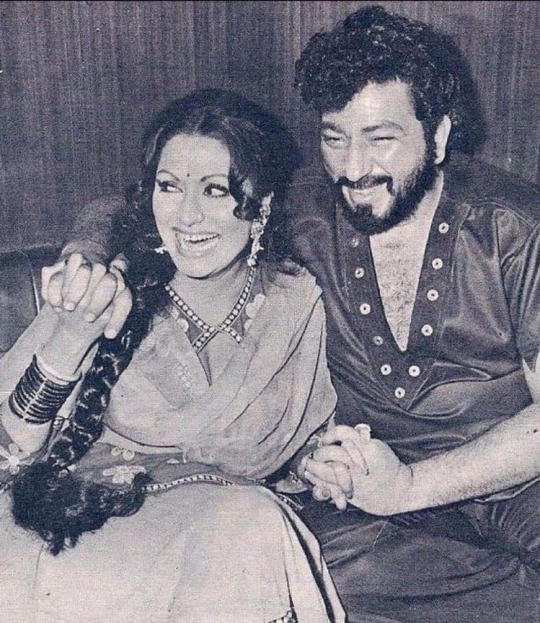
Happy Birthday, #Bindu (17/04). What are your favourite films of Bindu Ji?
10 notes
·
View notes
Text
"Issam Hajjaj, 27, survived the massacre and spoke to Mondoweiss. 'We were running away from bombing and killing. In all directions, there was either bombing, an Israeli tank, or Israeli gunmen shooting at anyone in their path,' he explained. 'While we were running away from death, I saw dismembered bodies on the road as a result of the bombing, and I saw those who left their loved ones under the rubble and fled to save the rest of the family. We did not know from which direction death would come for us.'
... 'During our escape, we saw bodies being loaded into cars heading to Al-Aqsa Martyrs Hospital. Women were screaming in the streets, and children were crying and screaming,' Hajjaj recounted. 'I saw a family that was fleeing together. A shell fell on the father and killed him in front of his wife and young daughter. After the mother got up and carried her daughter, she discovered that her husband was killed; she left him on the ground and fled to save her daughter and herself.' Hajjaj explained that the targeted location was two buildings near Al Awda Hospital in the Nuseirat camp, but to reach these two buildings, the Israeli army destroyed an entire residential square.
... Tawfiq Abu Youssef, an 11-year-old child, sits in Nasser Hospital in Khan Younis where he was referred to for treatment. His face is bloodied and his eyes are swollen blue after he was pulled from under the rubble of their home in Nuseirat. He says he doesn’t know how he escaped death. ... 'Before our house was bombed, we saw people in the street across from our house on the ground cut up. We saw missiles hitting the people fleeing in the streets, how they cut them off, and how the planes bombed everything moving in the streets – cars and people. The street was full of people, and suddenly, all of them… They were on the ground, and smoke and blood filled the place. Everywhere we looked, shelling and shrapnel were flying.'
... The operation was carried out near a central market, where Amjad Abu Laban, 43, was selling some food items on the road. He survived death but suffered various injuries to his hand and foot. He says that everything started at once: planes, tanks, shooting, and people were in the middle of bombing and death and did not know how to react or where to turn.
'Intense bombardment began in several areas in front of us, around us, and behind us, and people began falling to the ground by the dozens near Al-Awda Hospital in the Nuseirat camp. Before our eyes, we saw bodies being torn apart and scattered on the roads, and we saw soldiers hidden in civilian clothes and in people’s cars running and killing everyone they met on their way without distinguishing between a child, a woman, a young person, or an old person. We saw the bodies of our brothers cut up, without heads, lying on the ground,' Abu Laban told Mondoweiss. 'These massacres that occurred before my eyes cannot be described.'
In the same hospital, Mahmoud Al-Hawar, 27, lies on his back as a result of an injury to his leg. Al-Hawar witnessed the massacre as he bravely attempted to save his family and neighbors from the bombing. 'The planes bombed our neighbors’ house, and there was a girl under the rubble screaming to be saved. I went with my friends to try to save her, but the rubble was heavy, and we could not dig her out or even lift it to reach that girl, so we waited until the civil defense team arrived. A large number of young men gathered to try to rescue them. But the planes bombed us,' he told Mondoweiss.
Al-Hawar recounted that he felt the missile hit him and his group of friends and they were thrown to the ground. Minutes later, Mahmoud regained consciousness and found himself covered in blood and saw his friends next to him, on the verge of death. 'Before we were bombed, if I told you that I saw more than 10 drones above our heads, you would not believe it. We were looking at the sky and did not know what was happening.' After the bombing, Al-Hawar tried to stand up to save himself and his friends. 'I tried to stand up, but I couldn’t. I was covered in blood. I looked at my leg and it was cut off. I looked at my best friend next to me, and I found him taking his last breath.'
Their injuries were all severe, and when someone arrived who could take them to the hospital, the five friends were placed on top of each other in a small transport truck, with Al-Hawar underneath them all. 'I was in pain from my injury, but I was feeling more pain because I could hear my friends pronouncing their martyrdom and taking their last breaths. All my friends were dying above me, and I was hearing and feeling everything. They were all killed. Some of them were martyred on the road before my eyes, and some of them died later.'
Al-Hawar agreed that the scenes he saw of the dead in the streets will never be forgotten. 'I have not slept since the incident. I cannot sleep. I cannot forget anything I witnessed and saw. I cannot forget the people who were running in panic and fear, searching for their relatives and families amidst the destruction and dismembered bodies.'
Rescue teams are still working in Nuseirat with limited capabilities in an attempt to recover the bodies that remained under the rubble. Many residents remain missing due to the massive bombing in the area, and the many homes that were demolished, some on top of their residents. Many others were killed in the market as they tried to meet the needs of their families."
552 notes
·
View notes
Text
उतर आयी अखाड़े में Utar Hai Akhade Mein Song Lyrics- Chameli Ki Shaadi
Hello friends if you are Looking Utar Hai Akhade Mein song lyrics then you landed right place so don’t worry relaxed and enjoyed the Chameli Ki Shaadi movie all songs lyrics peacefully at one place. You can find and read this lyrics easily in any smartphone and Tablet such as Samsung, Motorola, Sony, Xiaomi, Vivo, Oppo, LG, Huawei, Asus, Lava, Micromax, iTel, Nokia, Oneplus, iphone, HTC and other…

View On WordPress
0 notes
Text

chehre pe mere zulf ko phailao kisi din
kya roz garajte ho baras jaao kisi din

razon ki tarah utro mere dil main kisi shab
dastak pe mere haath ki khul jaao kisi din

pedon ki tarah husn ki barish main naha lo
badal ki tarah jhoom ke ghar ao kisi din

khushbu ki tarah guzro mere dil ki gali se
phulon ki tarah mujh pe bikhar jao kisi din

guzren jo mere ghar se to ruk jaen sitare
is tarah meri raat ko chamkao kisi din

main apni har ik saans usi raat ko de dun
sar rakh ke mere senay pe so jao kisi din
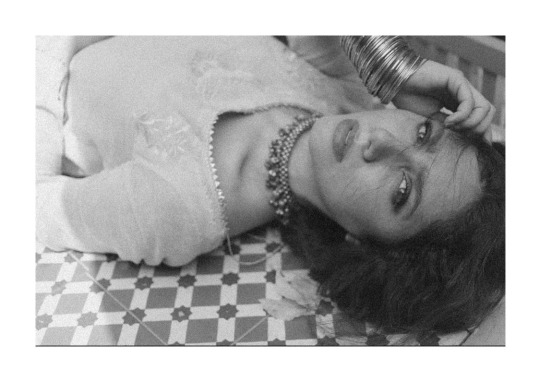
-Amjad Islam Amjad
#amjad islam amjad#urdu#mahira khan#mehreen khan#poetry#desi#pakistan#dark academia#pakistani#desi academia#urduposts#light academia#اردو غزل#urdu literature#urdupoetry#اردو پوسٹ#اردو ادب#اردو#desi aesthetic#desiblr#desi tumblr#lollywood#poetry in translation#poetry blog#muslim posts#dark academia aesthetic#romantic academia#black and white#bnw#urdu shayari
101 notes
·
View notes
Text

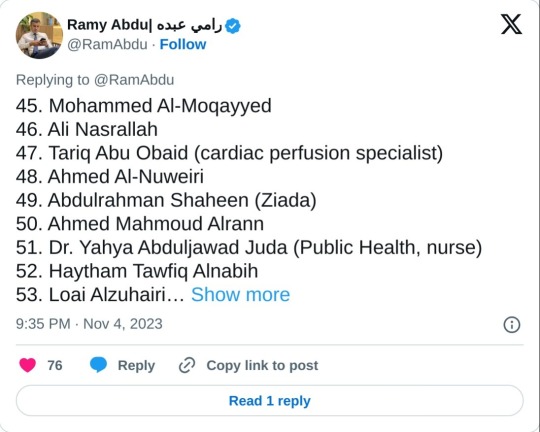
List of healthcare workers killed by Israel attacks on Gaza since October 7, 2023
Physicians:
Dr. Omar Ferwana, a Professor and former Dean of the Islamic University of Gaza Medical School and an andrologist, Gaza
Dr. Aya Ferwana (Dr Omar Ferwana’s daughter), a family medicine specialist, Gaza
Dr. Medhat Saidam, a senior burn and plastic surgeon, Shifa Hospital, Gaza and MSc in Burn Care alumnus from Queen Mary University of London
Dr. Mohammed Dabour, a consultant pathologist and dean of pre-clinical medicine at the Islamic University of Gaza Medical School
Dr. Tamer Al-Khayyat, an anesthesiologist and intensivist, European Gaza Hosptial, Rafah
Dr. Mahmoud Al-Khayyat, an internist in Rafah and Dr Tamer Al-Khayyat’s father
Dr. Razan Al-Rakhawi (Dr Tamer Al-Khayyat’s wife), an obstetric and gynecologist, Emirati Women’s Hospital, Rafah
Dr. Sereen Al-Attar a consultant obstetric and gynecologist at Nasser Hospital, Khan Younis and an Assistant Professor at the Islamic University of Gaza Medical school
Dr. Saeed Drabieh, a urology resident, Shifa Hospital
Dr. Mohammed Al-Samarai, Iraqi volunteer intern physician
Dr. Rafat Abou Foul, radiologist, Beit Hanoun Hospital
Dr. Amal Al-Maqadma, family medicine specialist, Rafah
Dr. Ibtihal Al-Astal, intern doctor, Khan Younis
Dr. Duaa Awad, emergency medicine doctor, Al-Aqsa Hospital
Dr. Moath Nabaheen, emergency medicine doctor, Al-Aqsa Hospital
Dr. Youssef Jadallah, intensivist and anesthesiologist (based in Germany, from Gaza but was visiting his family)
Dr. Inas Yousef, emergency medicine doctor, Al-Aqsa Hospital
Dr. Israa Al-Ashqar, anesthesiology resident, Shifa Hospital, Gaza
Dr. Abdallah Ashour, emergency medicine doctor, Nasser Hospital, Khan Younis
Dr. Hamam El-Deeb, orthopaedic surgery resident, Shifa Hospital, Gaza
Dr. Munther Abu Sariya, consultant pediatrician, Mohammed Al-Durra Pediatric Hospital
Dr. Doaa Shammout, pediatric resident, Rantisi Hospital, Gaza
Dr. Baraa Abu Elaish, intern doctor, Gaza
Dr. Abdlallah El-Helou, general practitioner/internal medicine doctor, Indonesian/Beit Hanoun Hospital
Dr. Muhannad Ezzo Afana, general practitioner, Gaza
Dr. Mohammed Refaat Mekki,
Dentists:
Dr. Ahmed Al-Hourani
Dr. Nada Mahdi
Dr. Ibrahim Al-Dali
Dr. Bilal Lubbad
Dr. Marwa Swelim
Dr Areej Eid
Dr. Tawfiq Al-Farra
Dr. Abdallah Baghdadi
Dr. Jameel Tarazi
Dr. Maysoon Al-Nuweiri
Dr. Mona Dughmush
Dr. Noha Dughmush
Dr. Mamoun Afana
Dr. Mohammed Afana
Dr. Anis Mekki
Dr. Tasneem Abdulnabi
Medical/dental students:
Bisan Halasa
Shaimaa Saydam
Abedelrahman Abu Shammala
Nour Al-Ashqar
Yaseen Al-Akhras
Osama Abu Safia
Duha Dughmush
Haneen Al-Shannat
Abdallah Abu Jayab
Zainab Azzam
Mohammed Abu Jiadan
Medical Scientists:
Prof. Salah El-Din Zanoun
Prof. Ahmed Al-Dalo
Prof. Ameed Mushtaha (Head of laboratories department and blood banks
Nurses:
Mohammed Lubbad
Mohammed Al-Azzaiza
Ahmed Moshtaha
Rami Lubbad
Somaya Temraz
Mohammed Rafat Gomaa
Osama A'eed Abu Safiya
Saber Al-Nimnim
Mohammed Hamad
Mohammed Al-Baz
Suleiman Abu Zour
Badr Mohammed Abu Daqah
Shaimaa Rayan (Midwife)
Maryam Abou Daher
Kefah San’allah
Walaa Adwan (Midwife)
Rawaa Al-Thalathini (Midwife)
Samah Rasheed (Midwife)
Rida Al-Masri (Midwife)
Ibrahim Abou Isaac
Amjad Abou Ouda
Ibrahim Al-Farra
Aya Al-Shrafi
Tamer Al Efesh
Momen Mansour
Asmaa Al-Asar
Feras Ftaiha
Diaa Bardaweel
Rana Shalaby
Itemad Miqdad
Zainab Al-Sharafi
Hamdan Malaka
Suheer Jbara
Hassan Al-Hennawi
Sabha Al-Sherafi
Azmi Al-Jamal
Yousef Al-Shareef
Hadeel Fanqa
Emad Esleem
Enas Al-Zeen
Heba Salamah
Nuha Esleem
Amro Masoud
Hanya Qudaih
Mohammed Al-Moqayyed
Ali Nasrallah
Tariq Abu Obaid (cardiac perfusion specialist)
Ahmed Al-Nuweiri
Abdulrahman Shaheen (Ziada)
Ahmed Mahmoud Alrann
Dr. Yahya Abduljawad Juda (Public Health, nurse)
Haytham Tawfiq Alnabih
Loai Alzuhairi (Nursing student)
Saleem Abu Zour
Waleed ElMahalawi
Rola Althalathini (Midwife)
Duaa Ashour
Amer Elramlawi
Safa Zeino
Saja Doghmosh
Moayad Ezzo Afana
Ramadan Doghmosh
Moemen Arab (Nursing student)
Oun Nofal Ashour (Nursing student)
Paramedics (EMS providers):
Marwan Abou Raida
Hatem Awad
Khalil Al-Sharif
Ahmed Al-Dahman
Yousri Al-Masri
Ahmed Abdel Rahman
Mohammed Al-Ghaliz
Mohammed Ali
Iyad Salim
Abdelrahim Abou Baid
Alaa Abou Ghanima
Naji Al Fayoumi
Mohammed Qateet
Tareq Ashour
Mahmoud Abou Mashayekh
Nafeth Al-Natour
Mahmoud Othman
Mohammed ElOmour
Ibrahim Matar
Yasser Alnaseri
Physiotherapists:
Ahmed Al-Masri
Ahmed Sameh Abou Herbeed
Shaimaa Sbaih
Mayar Al-Wahidi
Ahmed Ashraf
Shahrazad Al-Akhras
Nour Ibrahim
Pharmacists:
Ahmed Al-Jerjawi
Aziz Elfarra
Afnan Al-Astal
Shereen Abou Jazar
Eman Abu Al-Jalil
Safaa Hasouna
Ibraheem Meqdad
Mohammed Ali
Maysaa Khader
Nisreen Al-Dammagh
Sally Al-Aydi (Pharmacy student at AlAzhar University)
Mohammed Al-Shannat
Lina Abu Mualaileq
Noor Ibean
Haneen Albasyouni
Amira Dahman
Rawand Albanna
Khaled Abu Ma’ala
Amal Mekki
Abdullah Altartori (Pharmacy student at AlAzhar University)
Asmaa Abu Salah (Pharmacy student at AlAzhar University)
Mohammad Alshami
Lab technicians/clinical microbiologists:
Natheer Shaban
Asmaa Hijazi
Rawan Yassin
Alia Al Hinnawi
Maryam Kabaja
Nahid Abdullatef
Mohammed Abu Karsh
Mohammed Shabaan
Riham Elkahlout
Ismail Sharaf
Taiseer Alghouti
Abdulmohsin Abu Alrous
Duaa Jad Allah
Optometrists:
Omar Khorsheed
36 notes
·
View notes